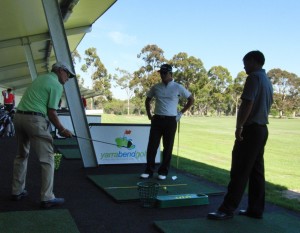
To get the best value from a golf lesson, there are a few prerequisites. Firstly you must be prepared to learn and possibly change some things. Most importantly you will need to practise your new skills and give them the opportunity to take effect. It is my experience, that one round a week and one practice session is about enough to maintain your standard. More is required if you expect improvement. You will get maximum benefit from your lessons and golf improvement if you have a good understanding of why and how your technique changes.
Technique will only change for one of three reasons.
1. Concept. A concept change is a conscious change. This is what most golfers see as the primary reason that a golf swing changes. Predominantly, golf lessons delivered by the instructor will deal exclusively with concept changes. A concept change occurs when a golfer’s technique is assessed and an error in technique identified. This can be a fault in any area of technique from the set-up to the timing of a swing and include every shot type from putting to driving. Generally what comes next is a drill or exercise to correct and override the fault and then lots of practice is required to ingrain the new correct technique.
2. Physical. A physical change occurs when the golfer’s body changes through injury, age, fatigue, other activities and even diet. All of these physical changes have an effect on the body. As a result, the golfer’s technique will change and most times negatively. Sometimes these changes affect us from one day to the next. This happens without any conscious or deliberate change in technique and can be very frustrating to identify. Unfortunately most instruction to correct these physical changes in the swing are attempted at the concept level. Think of this, if your technique changed without you knowing about it and it was a result of your body changing, wouldn’t it be better to correct the change in your body rather than react to the technique change in the swing? The answer, in case you’re not sure, is yes. For example: If you are suddenly not pivoting your hips well because you have a stiff back from gardening, then get a massage and stretch your back and your pivot will fix itself.
3. Reaction. A reaction change in technique is at a subconscious level and always a result of ball flight, contact or conditions. If a golfer has been slicing, their instinct is not to lose the ball right — and as a result they will nearly always start swinging across the line and spinning out of the shot. If the golfer was constantly making contact in the heel of the club, they might start pulling away from the ball on the downswing. If the wind on the practice fairway was straight in their face every day or there was any consistent abnormal conditions, they again would make an unconscious change in their technique as a reaction. Once again, attempting to correct a technique fault that is a result of a reaction change at a concept level will most times be frustrating and ineffective. To put it simply: if the fault in your swing is a reaction to slicing, then by learning to hook the ball, the technique fault will disappear.
There are eleven basic categories of shots in golf. Driver, fairway woods, long irons, mid irons, short irons, pitching, bunkers, chipping, long, mid and short putting. Very few rounds go by without you having to play at least one of each of these shots. I suggest that when you take your lessons, that your goal should be to become competent at all these shot categories. So take note, and keep some statistics, so you can tell your teacher what you need and want to improve upon.
There are two types of practice; to practise technique or to practise golf. When you are practicing technique you should only evaluate your success or failure by whether you are achieving the correct moves in your swing. When you are practicing golf, your success is measured by where the ball finishes — not whether or not you made a good swing.
After a lesson, you will most likely have been given a drill or an exercise to work on which is designed to enhance the feel of the modification your technique requires. To get the best value and to integrate the change quickly, I suggest that you rehearse the drill once, then have a practice swing sensing the feel of the drill in the swing and finally hit a shot after programming the feel of the improvement. So for a bucket of 50 balls, there should be at least 150 total swings.




